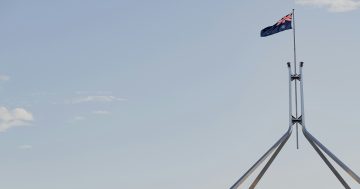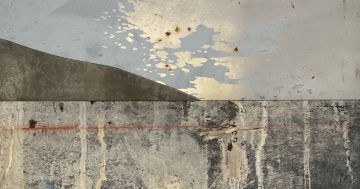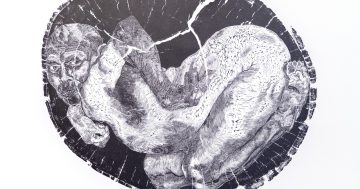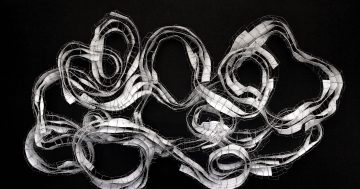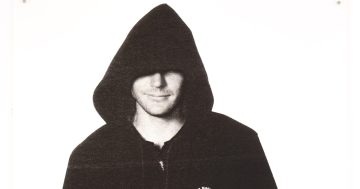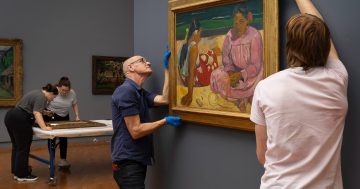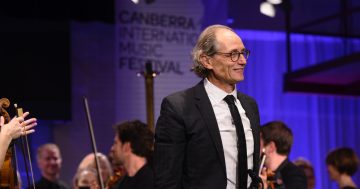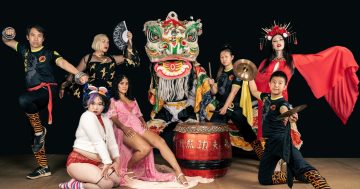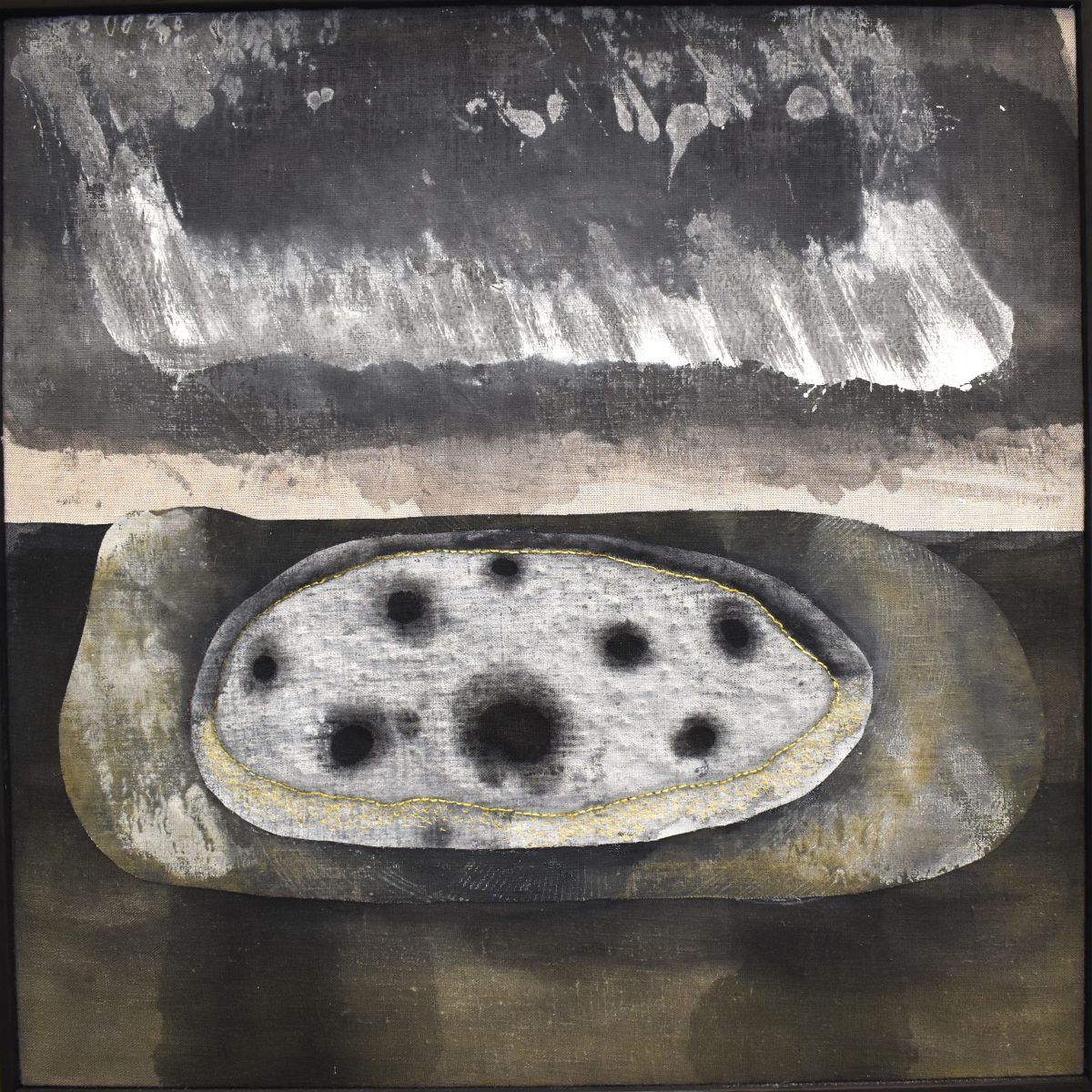
Mariana del Castillo, Bitter wounds of fire, 2023, collage, monotype repurposed linen, cotton, sumi ink and clay paint, 62 x 62cm. Photo: Supplied.
One can argue that with the exception of First Nations artists, all other artists working in Australia are ‘new arrivals’. This is despite the fact that some have been here for quite a few generations and may even trace their ancestry to migrants who arrived on the First Fleet.
Many artists speak of an ancestral heritage evident in their art – their Irish heritage, their Greek or Italian heritage or echoes of the art of the Pacific islands – even if they had been born in Australia.
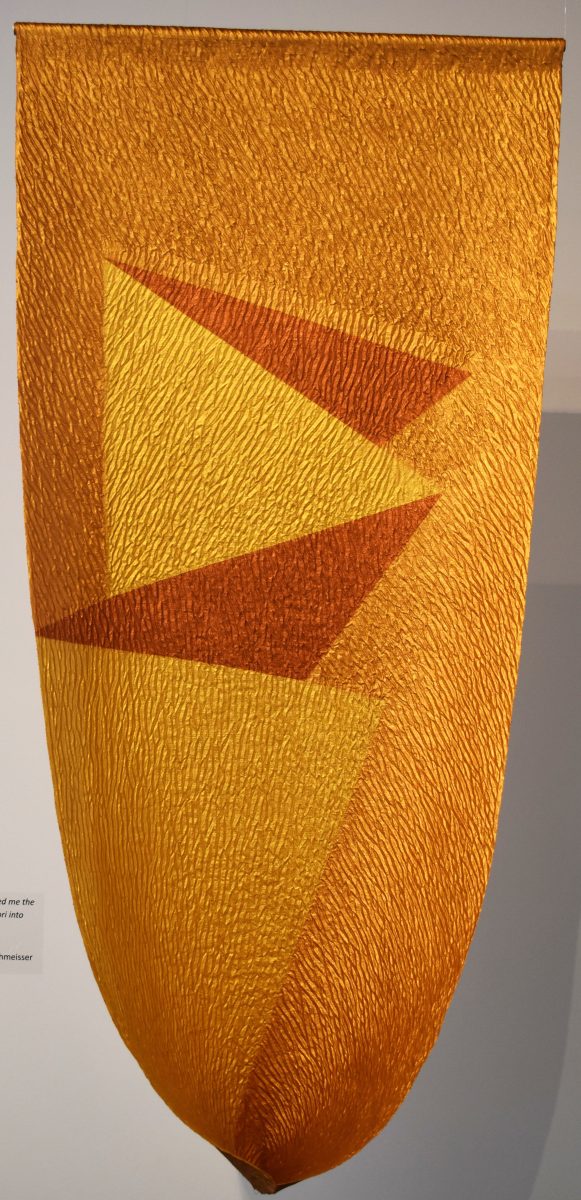
Keiko Amenomori Schmeisser, Folded Gold 1, 2019, shibori, acrylic paint on linen, 165 x 69cm. Photo: Supplied.
The exhibition at the Tuggeranong Arts Centre, Longing and Belonging, brings together the work of 10 women artists born overseas but now working in Canberra. Most of them have quite a high profile in the Australian art scene, and in their art practice, they recall their cultural origins. The 10 participating artists are Maiju Altpere-Woodhead, Keiko Amenomori-Schmeisser, Mariana del Castillo, Kirandeep Grewal, Sarit Cohen, Valerie Kirk, Pinal Maniar, Luna Ryan, Monique Van Nieuwland and Savanhdary Vongpoothorn.
Apart from being born in a country other than Australia, there is little that unites the art of these artists.
Keiko Amenomori-Schmeisser was born in Japan, trained as a textile artist in Germany and has been based in Canberra for many years. About 30 years ago she turned to the shibori technique (a Japanese dyeing technique that produces patterns on cloth) and has become an internationally acclaimed master.
Her Folded Gold 1, 2019, is one of the standout pieces in the exhibition – simple, at least at first glance, elegant and memorable. Her piece is very different from traditional Japanese shibori and incorporates metallic pigment in homage to the intense golden light in Australia.
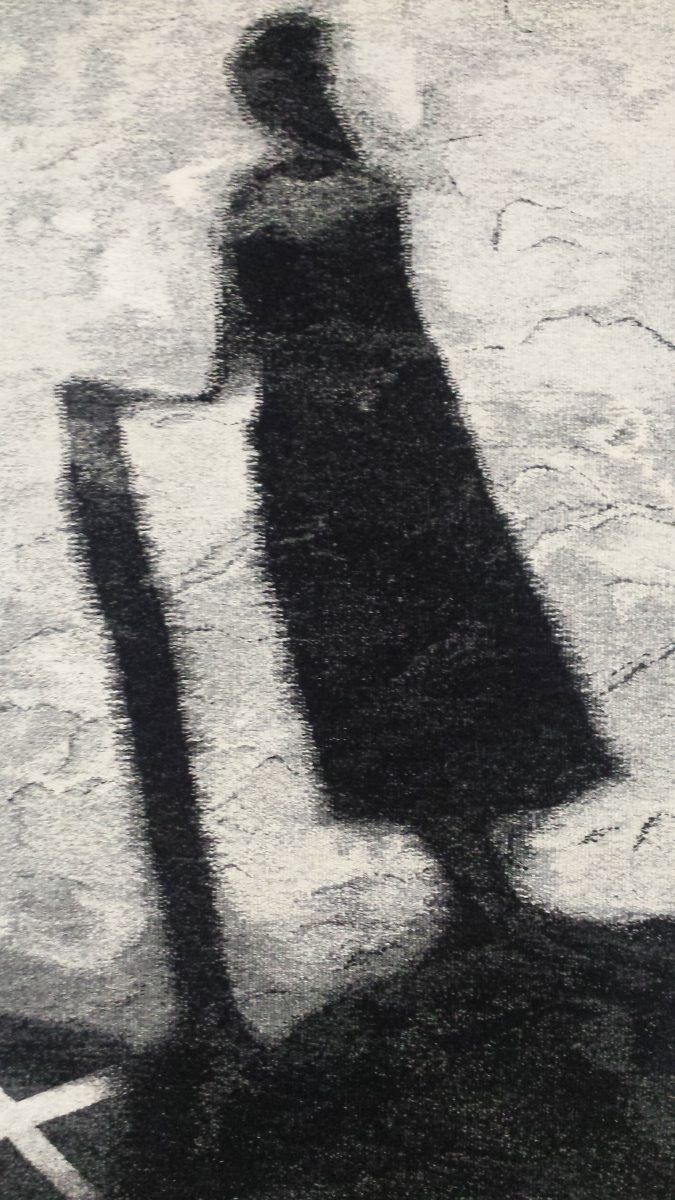
Valerie Kirk, The traveller, 2018, cotton warp, mixed weft yarns – woven tapestry, 147 90cm. Photo: Supplied.
Mariana del Castillo is an Ecuadorian-born artist who creates spiritually charged objects mainly from repurposed materials. Her pieces, including Bitter wounds of fire, 2023, are like little allegorical icons. They may appear on this land and comment on droughts, floods and bushfires; however, frequently, they contain a suppressed scream or a very personal lament. She is the rare artist who manages to combine a personal interior landscape within an outside local landscape narrative.
Valerie Kirk is from Scotland and is a Scottish-trained textile artist who, over many decades, has made a huge contribution to textile art in Australia. The selection of her work at this exhibition ranges from references to the crosses of Scotland through to her maverick woven textile, The traveller, 2018.
Kirk explains the context of its creation.
“While leading a textile tour in Peru, I noticed my shadow over rocks at an archaeological site near Ayacucho: a light, unfixed impression on the land. It looked as if I was holding a large walking stick, and in that moment, I recognised myself as a traveller exploring the world and not deeply rooted in a particular place. The photograph I took was adapted and re-drawn for the tapestry design. The image was woven over six weeks, from bottom to top, building the form with attention to the detail of every mark of weft over warp and through my deep immersion in the process.”
It is an effective, enigmatic and haunting piece.
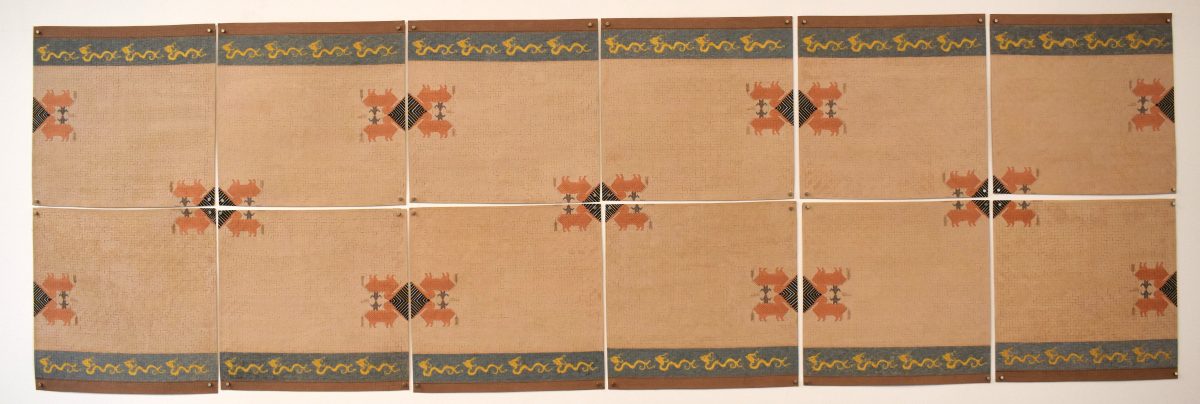
Savanhdary Vongpoothorn, Rama was a Migrant, 2016, pigment on woven mulberry paper, 78 x 240cm. Photo: Supplied.
Savanhdary Vongpoothorn fled Laos with her family as an eight-year-old child and is now a very widely celebrated visual artist resident in Canberra. Her Rama was a Migrant, 2016, is a very intricate piece made on woven mulberry paper with pigment. The narrative deals with Rama and Lakshmana sitting on their flying horse and the context is the Mekong River that flows through her homeland. It is a very subtle, understated image that reveals itself slowly as you peer into it.
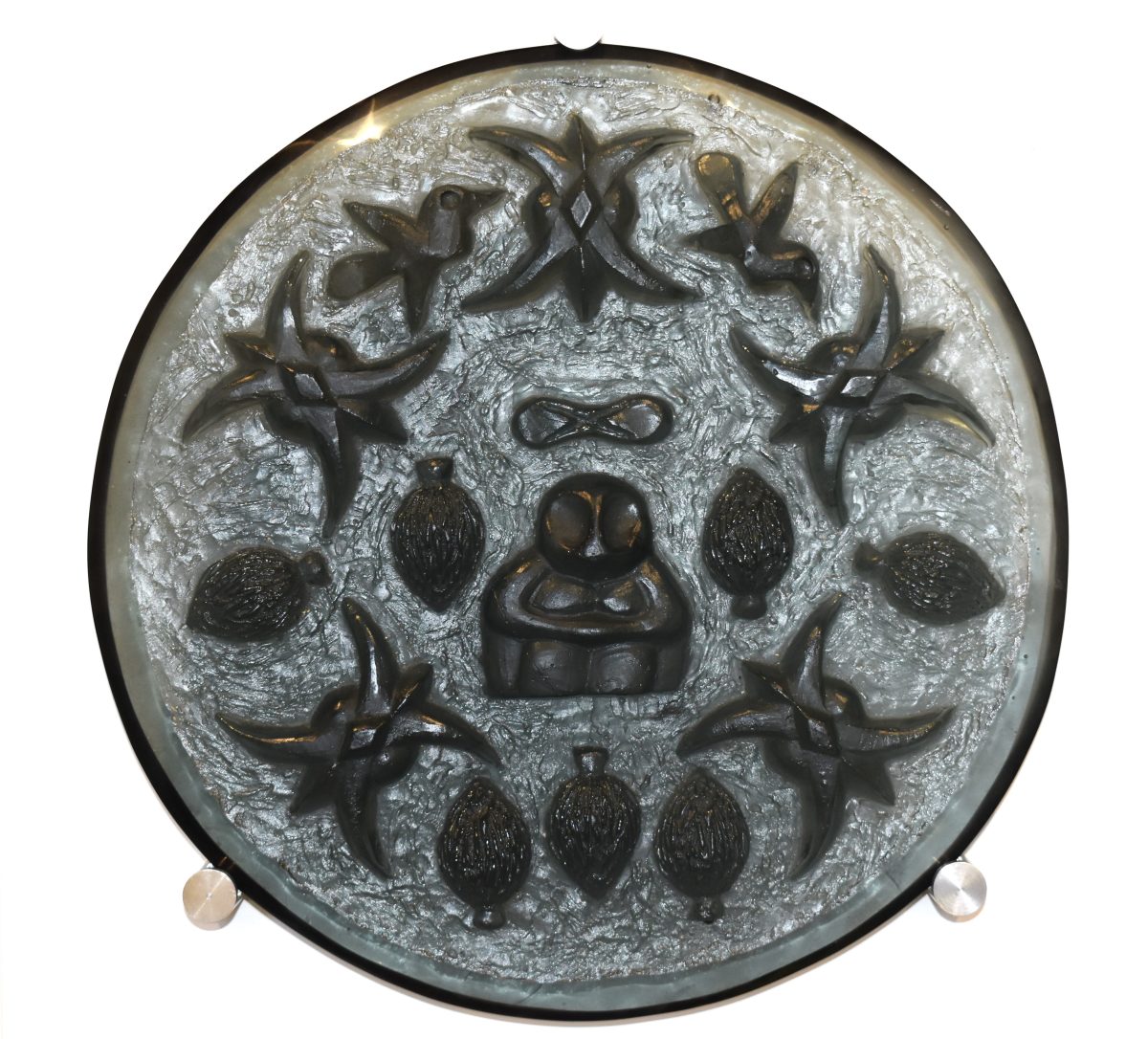
Luna Ryan, Vision of a fragile Eden, 2007, detail, cast recycled TV screen (7 panels), 45 x 45 x 10cm each. Photo: Supplied.
Luna Ryan is a Dutch-born glass artist who in very effective pieces, including Vision of a fragile Eden, 2007, casts her forms from recycled television screens. For a number of years, she has worked with the Tiwi people from Bathurst Island. This glass installation may be interpreted as a series of works commenting on the loss of the natural environment commencing with an image of bliss and concluding with a sawblade in the process of destroying Eden.
Many artists have embedded in their psyche a real or imaginary image of ‘home’ and this they employ to negotiate and make sense of the place which they now inhabit. This exhibition examines the responses of 10 artists living and working in Australia while carrying within them traces of a different culture.
Longing and Belonging at the Tuggeranong Arts Centre, 137 Reed Street, Greenway, runs until 12 October. It’s open Tuesday to Friday from 10 am to 5 pm and on Saturday from 10 am to 4 pm.











